Gosford Prisoner of War Camp 16
PLEASE NOTE - A CONTACT POINT FOR ANYONE WISHING TO CONTACT EX-PoWs
OR THEIR DESCENDANTS IS AT THE END OF THIS PAGE.

One of six etchings of Gosford PoW camp done in 1946 and presented to Captain William Graves, R.A. (see below).
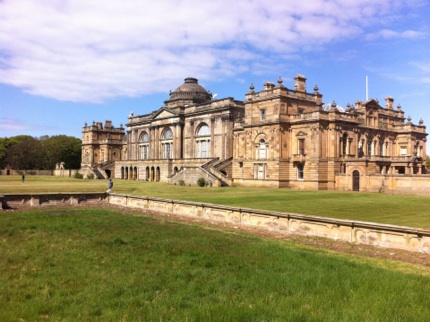
Gosford House showing the west facing side.
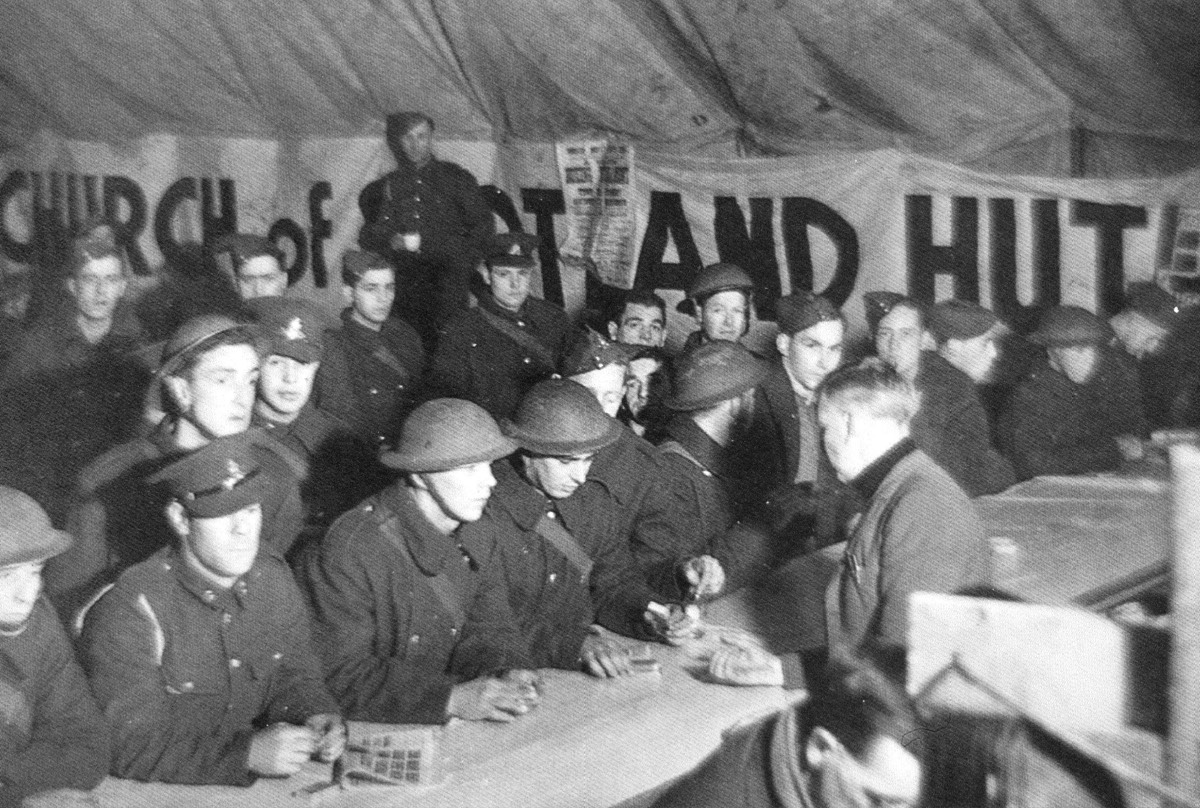
Waiting for a cuppa at the Gosford canteen in the days when the army used the estate.
PoW Camp 16: Gosford
The military facilities which had been built for the Royal Artillery on the Gosford estate of the Earl of Wemyss and later used to house the K.O.S.B., were vacated by the Poles in 1944 and became an obvious site for housing some of the sudden influx of German prisoners captured after D-Day. Some 3,000 German PoWs were brought from France and Belgium, transported to the station at Longniddry and marched into these facilities. Many of these, especially those in the Waffen SS who had come via camps in Belgium, were mightily relieved to reach it. It was a haven of peace compared to what they had experienced after capture.
Overcrowding was, however, rife and many prisoners had to sleep in tents up until Christmas 1944. Despite the initial overcrowding, facilities in the camp were good since much of the accommodation was in brick buildings (some of which remain) and prisoners had the use of a bakery, a cinema and theatre and, for sports, a football pitch and sports ground. Parts of the camp’s administration buildings as well as the camp cooler (or jail) still exist in the estate grounds. The interior of the latter has been photographed extensively by the author of coastkid.blogspot.co.uk in February 2012, showing the remains of prisoner signatures and graffiti.
While conditions were fairly crowded and the regime fairly tight during the remaining months of the war, conditions were steadily relaxed once the fighting ceased. Prisoners were ultimately all freed by 1947-8 and many had been able to either work (especially on local farms) or even wander at will once the Nazi regime had fallen.
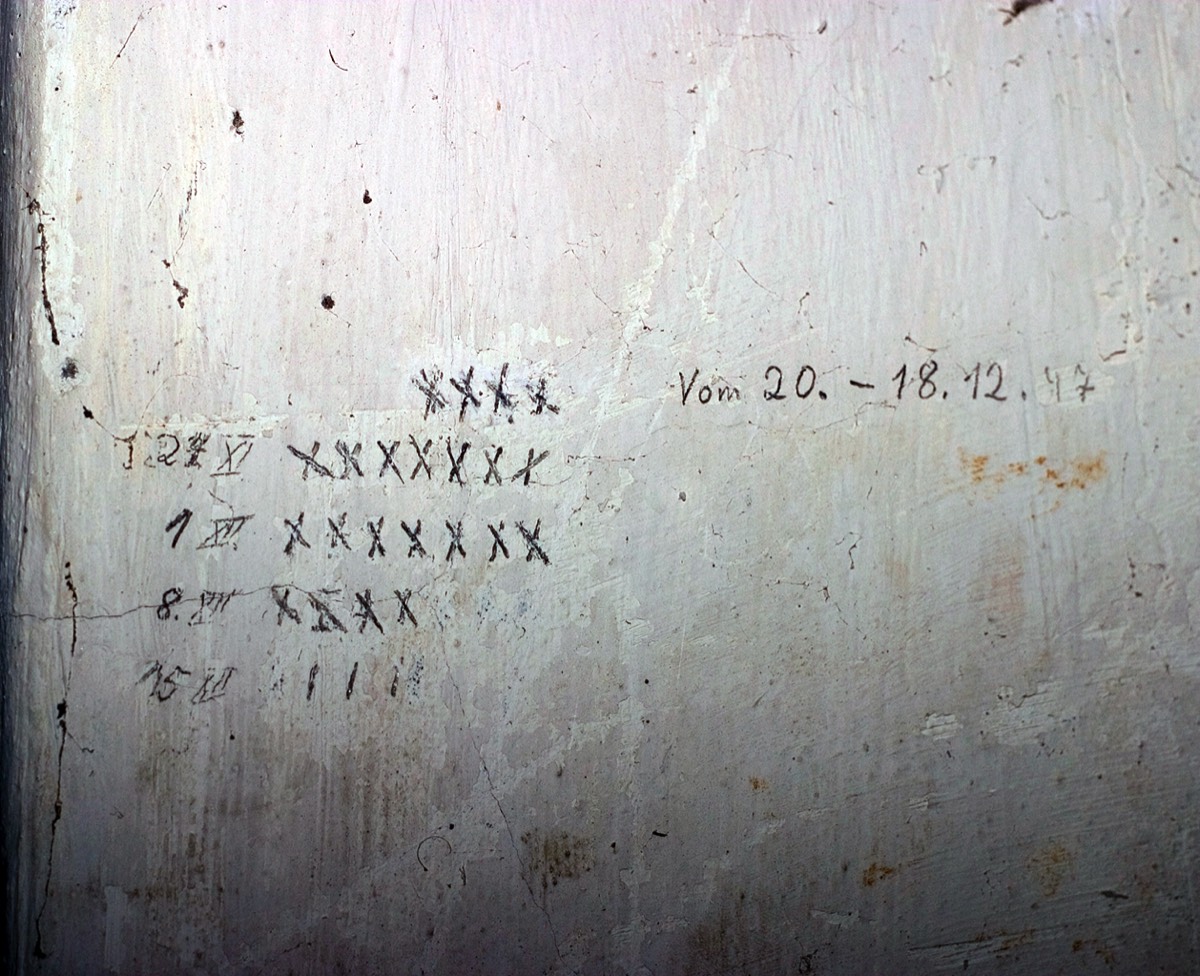

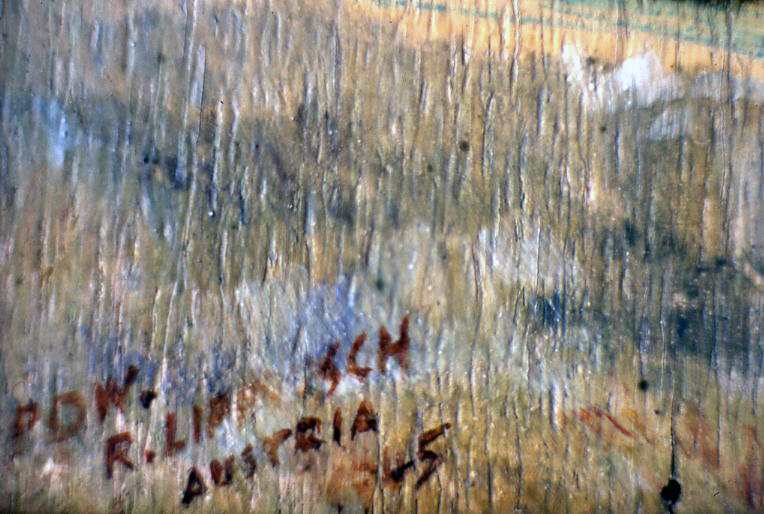

Two prisoners in the Gosford camp’s jail who, in time-honoured fashion, mark off their punishment in the cooler and one who clearly thinks of a well remembered church back home. The lower picture is that of an Austrian PoW’s signature.
Eyewitness - Harry Dittrich
Harry Dittrich had arrived in Gosford in 1944. Harry wrote:
“We were transferred [from a camp in Dumfries] to PoW camp 16 in Gosford, East Lothian. It was a large camp. On arrival we were all questioned about our place of birth. When I told them I was a Sudeten German they said, ’Nonsense, you are no German, you are a Czechoslovak!’ I took it as an insult. There were also a lot of Austrians and they got the same treatment. After a few weeks all the ‘foreigners’ were assembled and transported to PoW camp No 16A in Haddington, all eight hundred of us.
After two years in Haddington the camp was closed. We were sent back to the main camp in Gosford and that’s where the trouble started. After two years of comparative freedom, with hardly a wire round our camp, we were suddenly confronted by our old friends, the German Army sergeants, ordering us about. We couldn’t believe our eyes. It looked as though nobody had told them that the war was long finished. They strutted about in their uniforms, covered in medals. I had never seen so many Iron Crosses in my life. We found out later that they had all been fashioned out of tin from the cook-house and hand painted. The only thing missing in that camp was the old Hitler salute; it was unbelievable! And the majority of them were still Nazis.
The old sergeants went hysterical when we told them we weren’t in the German army any more. We refused to follow their orders, all one thousand of us. The guard had to be called out, bugles were blown and I believe even the Fire Brigade were there, but they couldn’t do a thing with us. Most of us ‘foreigners’ and trouble-makers were transferred to other camps up and down the country as soon as possible after that.”
Eyewitness - Horst Rossberg
Horst Rossberg was captured near Neufchateau, by Epinal, in France two days short of his eighteenth birthday. After a difficult time in a number of temporary camps in France, Horst was transported across the Channel to England and from there by train to Scotland. Horst came to Gosford and left this description:
Arrival in Gosford And Accommodation
“Near Edinburgh we were picked up by lorry and taken to Gosford Camp near the little town of Longniddry. Here in this main camp on the Firth of Forth approximately 3,000 German prisoners of war were accommodated. Until just before Christmas 1944, about 400 men had to sleep in tents, on straw sacks on the ground, because the camp was too full. One stormy night some of the tents collapsed over our heads and we had to spend the next days and nights on the floors of the permanent accommodation corridors. Because of the cold nights in the tents, we all had bad colds and some of us had bladder infections. However, after a few days the numbers in the camp reduced and we were all given proper accommodation.
The barracks were very large and we lived fifty men to a hut. These were painted inside by us with views of home [done] from memory on the walls above our bunks. There were some real artists among us. We also made little gardens in front of the barracks. In a large hall there were a theatre and cinema and left of the main entrance was a football pitch and a sports ground. Really, there was everything there that could make camp life more bearable.

The prisoners who staffed Gosford’s bakery.
At Christmas, celebrations were organised and each of us received some Weihnachstollen and Christmas cake and twenty Reichsmarks from the Red Cross. Around ten o’clock on Christmas Eve we were awakened by sirens and it was said that German aircraft were attacking Edinburgh, so, in accordance with the Geneva Convention, our camp was brightly illuminated with searchlights from the watch-towers.
Work Details
After Christmas the first work parties were detailed and we had the prospect of seeing another environment and other people. However, we had to sign an undertaking that we would establish no personal contact with civilians.
We were collected early in the morning by military and civilian lorries and brought back to the camp late in the afternoon. At the beginning the work was voluntary, but later it was compulsory for everyone. Every morning at six o‘clock and at six o’clock each evening, all 3,000 men had to stand in six rows on the main roadway of the camp for roll-call, taken by a British officer and four soldiers.
An Escape
One morning in the spring, the roll-call was not correct. It was called several times but a few people were missing and a short time later the officer, whom we had nicknamed ‘Lui’, came and ordered us, in German, to state from which barracks the men were missing. However, those responsible for each of the barracks remained silent. in the meantime, the guards had established that there was a hole in the barbed-wire fence under one of the watch-towers and that the four missing prisoners had left a cloth bag with food in it hanging on the wire. ‘Lui’ now ordered us to remain standing on the camp roadway and said that all 3,000 men would be inspected one by one so that the identity of the escapees could be established. During the roll-call there was unrest in the ranks and we were constantly being ordered to keep quiet. ‘Lui’ shouted: ‘If you are not quiet I will keep you standing here for three days.’ Immediately someone from one of the back rows shouted back: ‘That’s all right we’ve got three years.’ ‘Lui’ got very annoyed and wanted to know the name of the man who had shouted but could not find out. We all had to laugh because the caller was right - we really were prisoners for a further three years. As a punishment we all had to stand there without breakfast or lunch until the evening , but at six o’clock we got breakfast, lunch and supper all at the same time.
Working Parties On Farms
For some weeks in the spring of 1945 we had a very good working group on a farm near Edinburgh. The owner, a widow, had asked for eleven prisoners to do the work left over from the previous year which also included the harvest. We were very happy to do this work as there was a good atmosphere on the farm. Each day we would have our midday meal in the farmhouse at a long table covered with a white cloth, and a good meal was served. We also got something to drink, a sweet course, and there were even cigarettes for the smokers. In the afternoon cake, served with a large pot of tea, was brought to us in the fields.
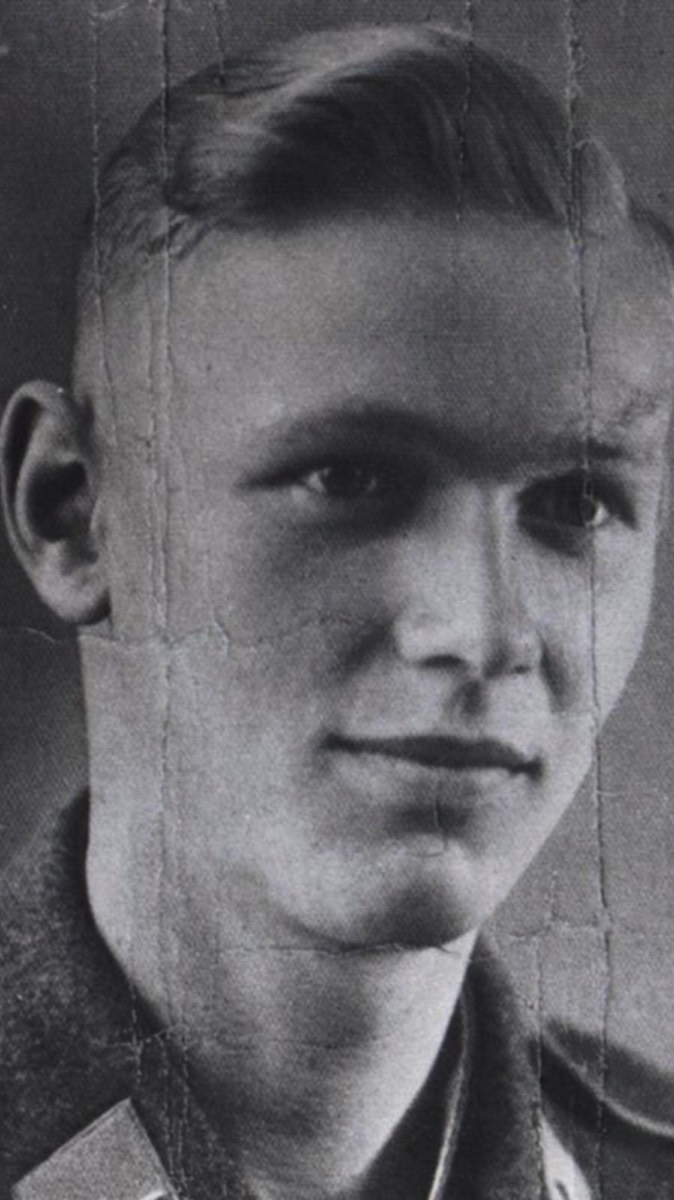
This picture shows Rolf in his uniform and the two below show him working on Wheatrig Farm.
My grateful thanks to Eileen Stahl for permission to use these photographs. She would be delighted if anyone recognised Rolf and was able to provide further details of his time in East Lothian. Anyone wishing to do so can contact me via the email contact below and I will pass on the information.
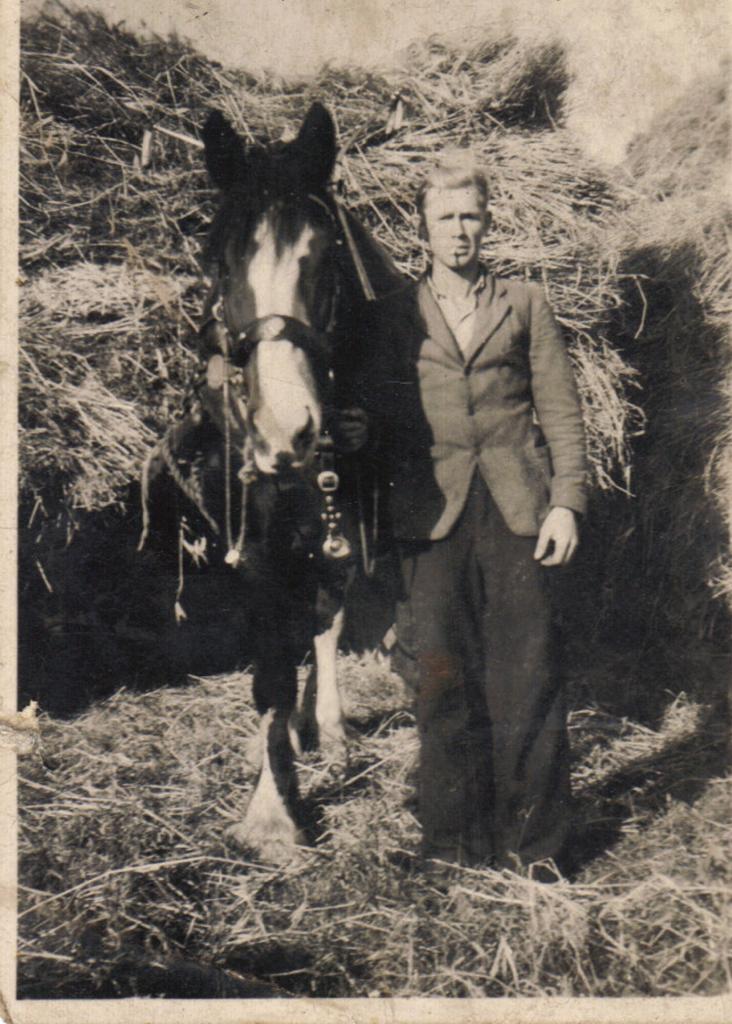
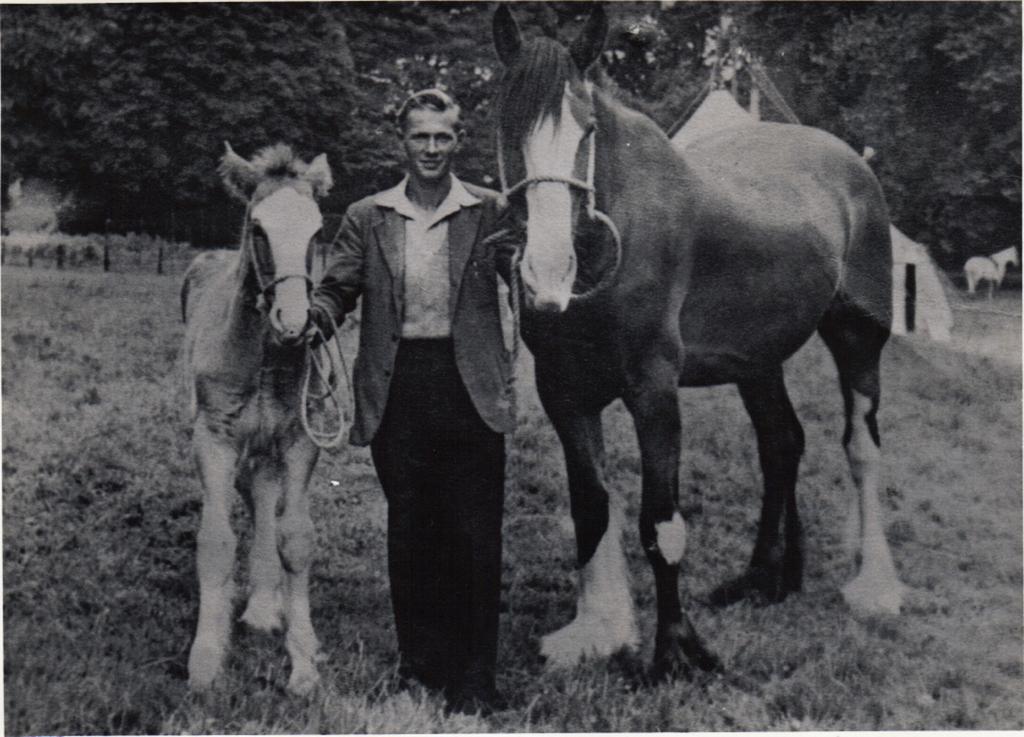
Peace
On May 8th, a very sunny day, the owner came in her car to where we were working and told us that Germany had surrendered and it was all over. We threw our arms round each other and shouted with joy. She could not understand our happiness and said, ‘You have lost the war: how can you be so pleased?’ We told her that we were happy that at last the war was finished, no more bombs would fall and our families would no longer need to fear for their lives. Also the time had come when we could reckon on a definite time for our release.
The work on the farm came to an end about this time. We took our leave of the farm owner on very good terms. She told us that we were very hard-working and had finished the work almost four weeks earlier than she had calculated.
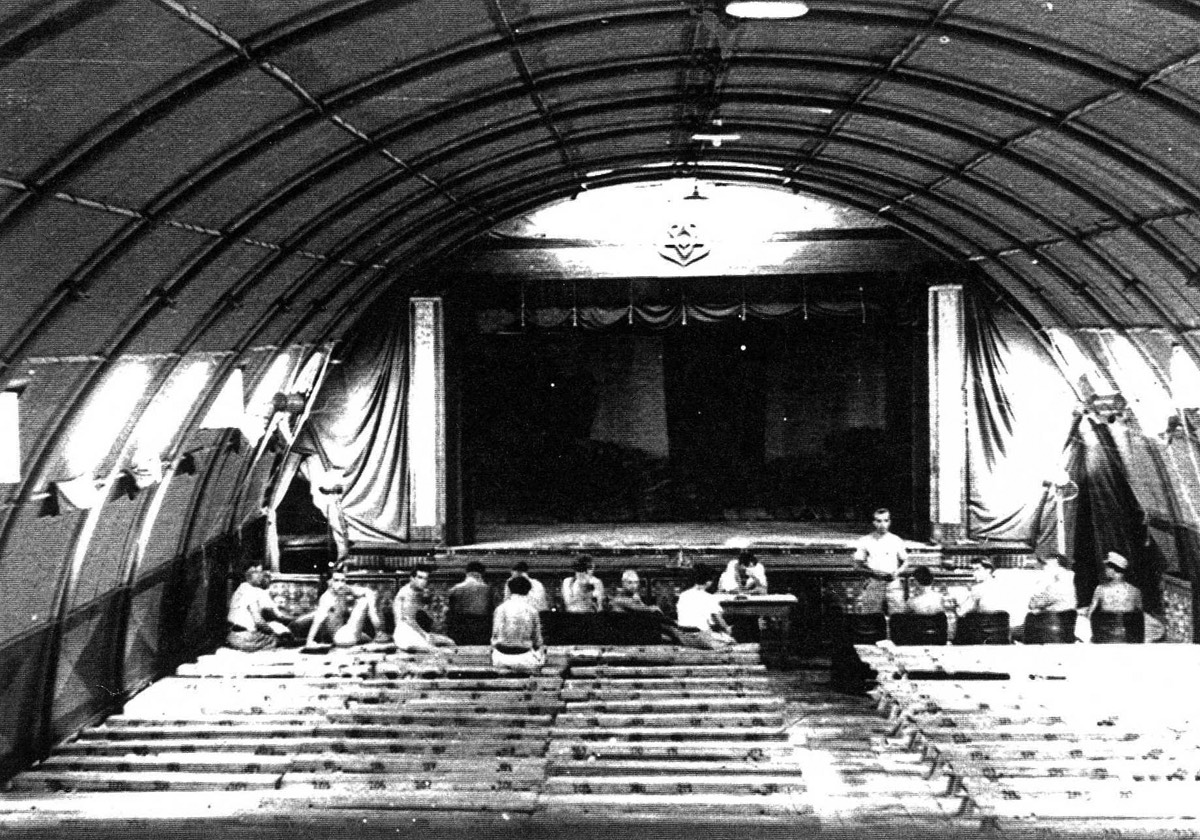
Gosford’s concert hall. If the history of other camps is anything to go by, this would have been a busy place.
The weekends passed in the camp with sport, games, theatre and colourful concerts. We had a band in the camp with thirty musicians and every imaginable instrument. This band also went to Edinburgh to play before members of the British Army. In the theatre some men had to play the female parts and they were so convincing that the camp commandant believed we had smuggled women into the camp!
News Of Concentration Camps
One evening when we returned to the camp from work we had to remain at the camp gate. There were about 200 prisoners there from the groups that had already arrived, and we were marched under guard to the camp theatre. Here, we were shown a documentary film about the recently discovered German concentration camps. What we saw then was incomprehensible to us. We simply could not come to terms with the fact that those capable of such acts had formed our government. For young people like us, the world in which we had lived as children and in whose schools we had been educated, crumbled.”
[My thanks to ‘After the Battle’ for permission to quote this account from its 1990 issue no. 76]
Horst was later moved to Stobs Camp, near Hawick, and a number of other camps before his release in March 1948.
Gosford's Coins
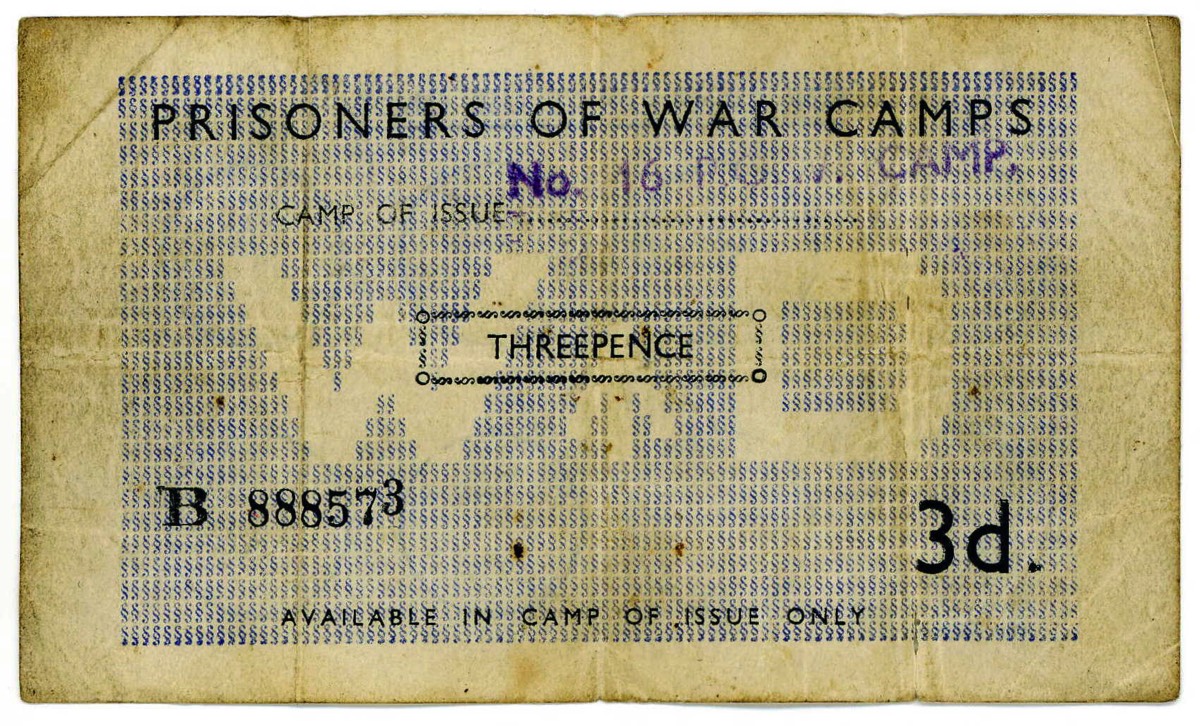
‘Currency’ used in Gosford PoW camp.
Prisoners were not allowed to have Sterling in their possession.

1942 20 centimes coin.
One former prisoner at Gosford, Rudi Franzel, remembered one way the prisoners had of obtaining the forbidden Sterling. In the months after the end of the war, some prisoners made small wooden toys which Rudi and others took out of the camp in ammunition boxes to sell around Arthurs Seat. He said that they disappeared fast as locals stocked up for a birthday or Christmas. Sometimes cash owed to the prisoners was thrown over a prearranged spot in the wire at an agreed time.
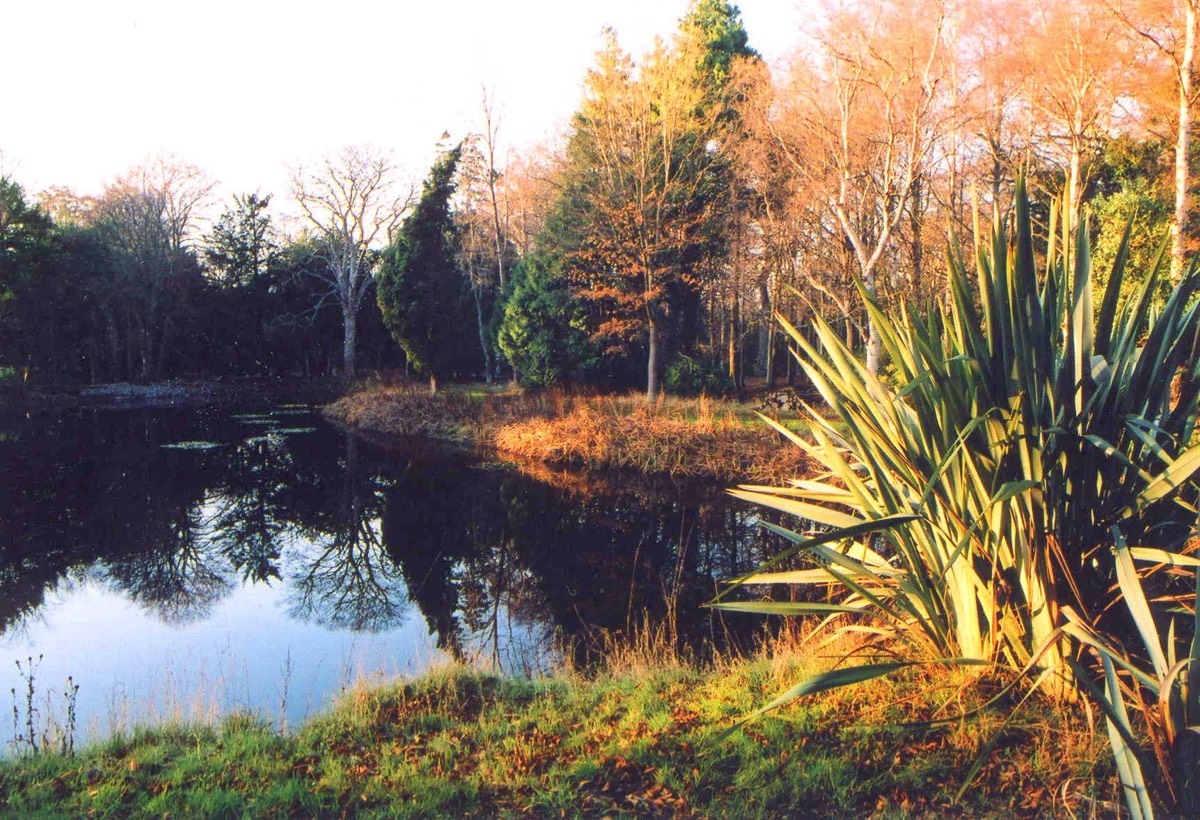
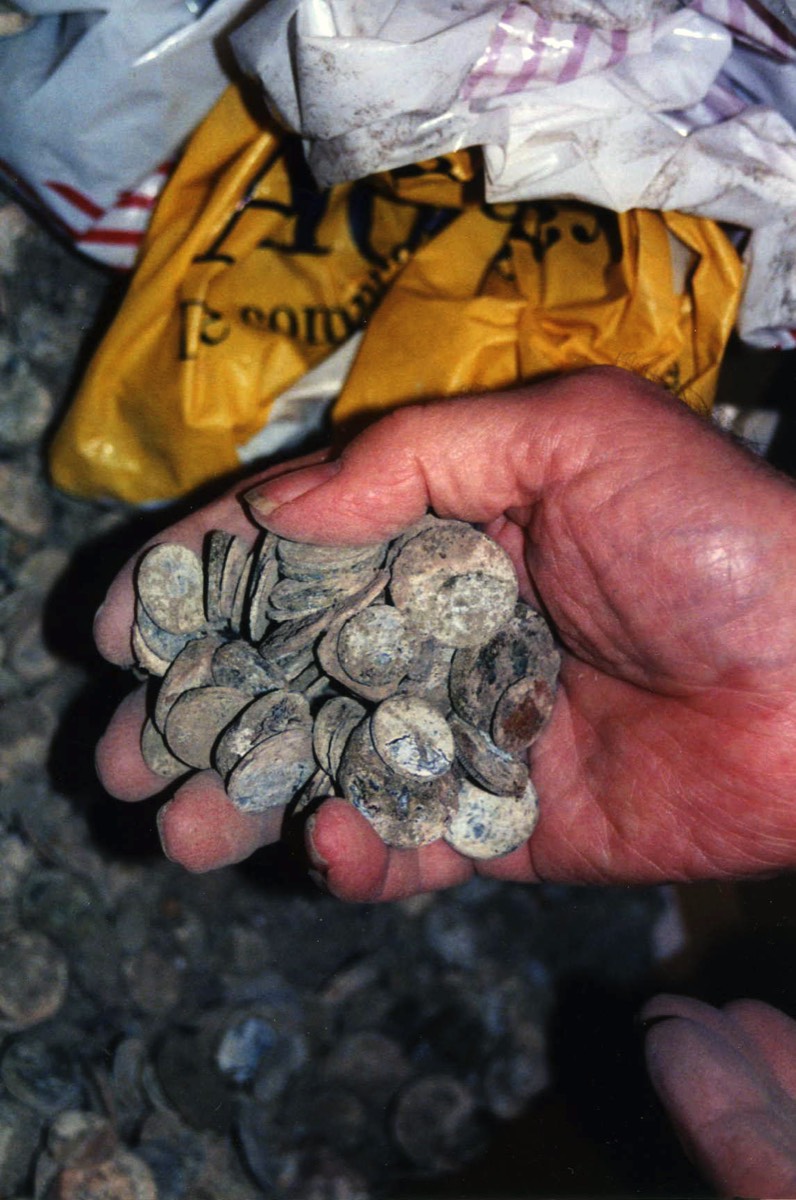
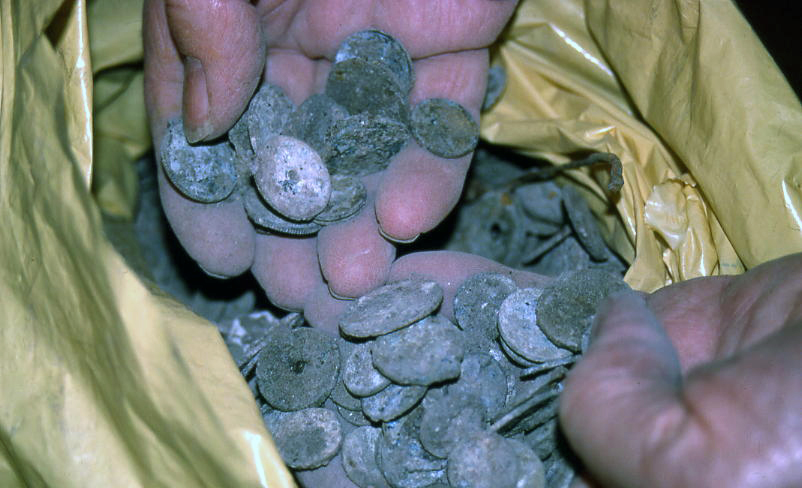
Salvaged wartime coins from Gosford ponds.
Entertainment At Gosford
As is made clear in Horst Rossberg’s account, prisoners at Gosford were able to choose from or participate in a wide range of entertainments. There was an excellent Concert hall which could be used for any large scale event and also doubled as a theatre or a film house. Prisoners put on shows and musical entertainments and, like their counterparts in Occupied Europe’s PoW camps, they had to play all the roles, male or female. Chess was a popular pastime and Karl Gilg, later an International Master and a chess player who had represented Czechoslovakia pre-war, was a prisoner at Gosford over three months in 1947 and well able to pass on a few good moves. Given the much increased freedom prisoners were allowed after the war ended, many people like Gilg were able to visit the similarly inclined, for example to play chess at Edinburgh Chess Club. If more inclined to the physical there were plentiful opportunities to play team sports in the sports field.
Escapes From East Lothian Camps
Roll calls were a necessary if trying feature of camp life, but despite them two twenty-four year olds, SS Sergeant Gotfried Lachmann and Corporal Paul Schmucker, escaped from Gosford in September 1944. Both were later recaptured. A further German PoW, Karl Lasar, aged forty-four, escaped from a working party in Haddington in 1945. PC Erskine related the details in his report:
“On Sunday, 18th April 1948, about 4.20pm, the skeleton of a human being was found on the west banking of the disused quarry situated about 200 yards east from the Birk Hedges Road, in the parish of Haddington, and the remains are suspected to be those of No A989611 Karl Lasar, (44), PoW, who was an inmate of No 16A Prisoner of War Camp, Amisfield Park, Haddington, who went missing from a working party employed at Dovecot Farm, Haddington, on 7th September, 1945. The cause of death is not certified.”
It’s more than likely that Karl took his own life as Willie Downey, one of the three young boys who made the unpleasant discovery, described in 1998. He described how the boys were looking for frog spawn in the Spring of 1948 when one of them kicked what he thought was a sheep’s head in the water. A closer look led to the realisation that it was a human skull with the remains of boots and a uniform with patches nearby. Willie noticed a length of hemp rope hanging from a nearby tree which overhung the quarry and remembered that identity discs were discovered along with a watch.
Down Memory Lane
An unknown number of former PoWs have now been able to make the sometimes nostalgic journey back to Gosford. Since the collapse of the USSR and the unification of the Federal Republic with East Germany a number have been become free to make a journey they had wanted to make long ago. One such was Alfred Weiss who, with his daughter and grand-daughter, revisited Gosford in July 2008, sixty-one years after he’d left it a free man once again. Rudi Franzel, also a former PoW at Gosford and at Amisfield, was there to welcome Alfred back.

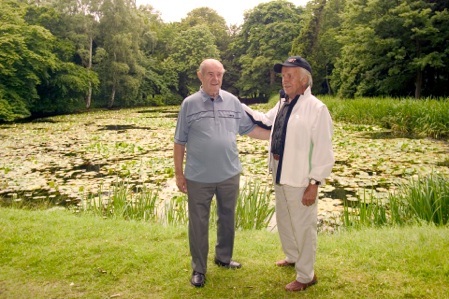
Rudi Franzel (on the left) and Alfred Weiss greet each other
by Gosford’s ponds in 2008.
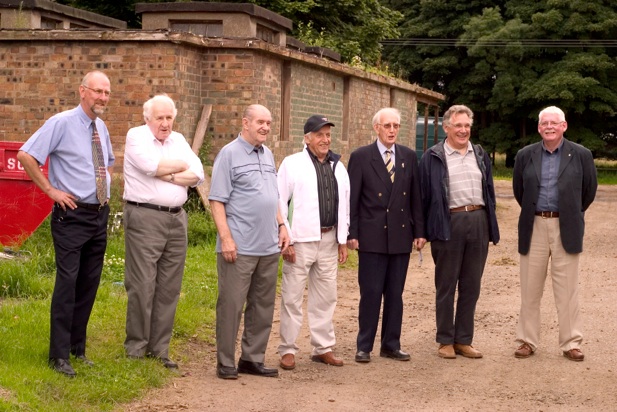
DH, JTJ, Rudi Franzel, Alfred Weiss and three members of Longniddry Rotary Club who assisted Alfred with his travel arrangements, etc.
Behind the party are some of the original prison camp buildings.
Etchings Of Gosford PoW Camp, 1946
The following six etchings were made by two German prisoners as a presentation set given to what we thought was the camp’s Commanding Officer and his wife at Christmas, 1946. The recipients were Captain William Henry Graves, Royal Artillery, and his wife, Ella. However, Malcolm Sanders kindly got in touch and pointed out that PoW camp Commanding Officers were either Majors or Lieutenant Colonels. He added that, "… two reports [were] issued either side of Christmas 1946 (July 1946 and January 1947) – where the Commandant was listed as Lt Col F A Hewat, M.C." Who Captain Graves was, therefore, remains for the moment a mystery. Malcolm also points out that the etchings were presented by the Camp Leader at the time, F. Pohlandt, the person named on the dedication page.
The occasion of the presentation, which also included jewellery and sewing boxes for Ella, was either the closure of the camp or of the transfer of Captain Graves to other duties. The etchings have been very kindly donated to us for educational use only by Captain Graves’s son, Peter. They can now be seen in the Archive and Local History Section of the John Gray Centre, Haddington.
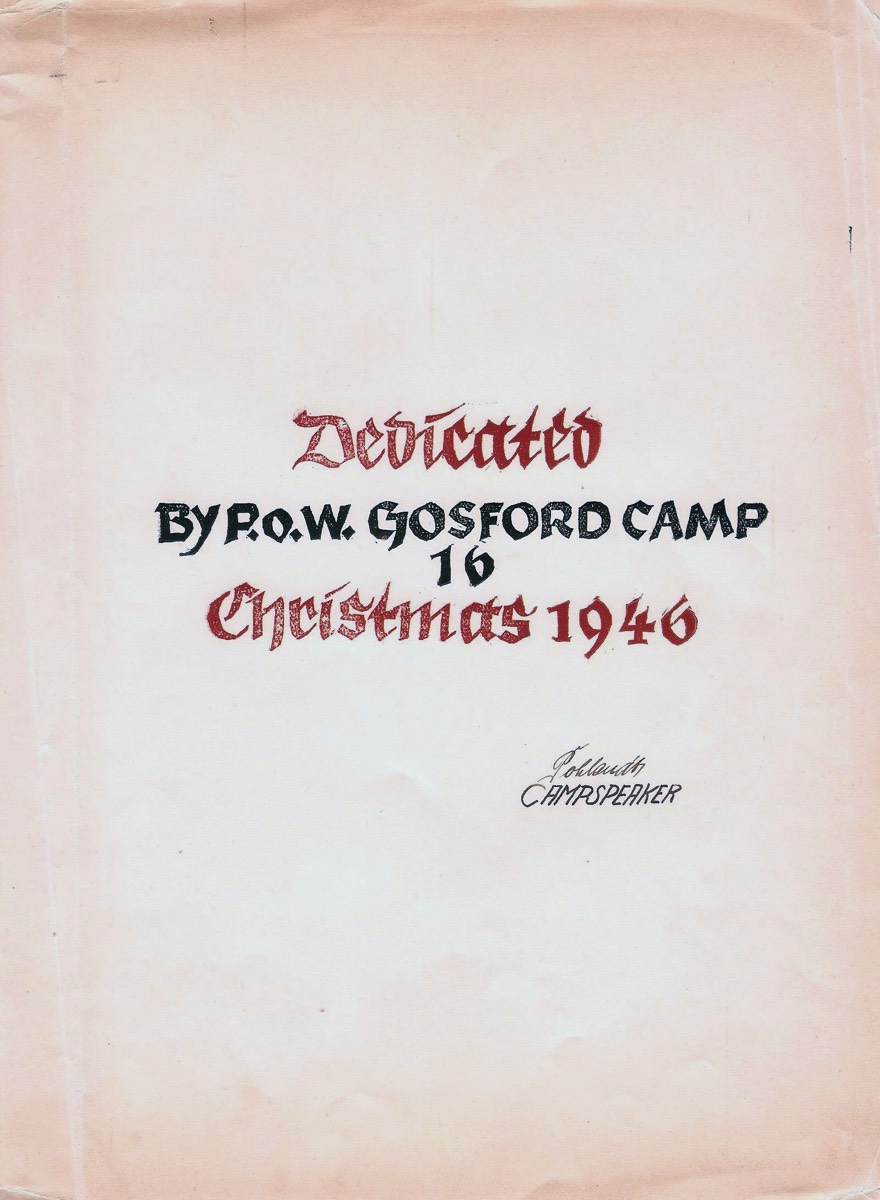
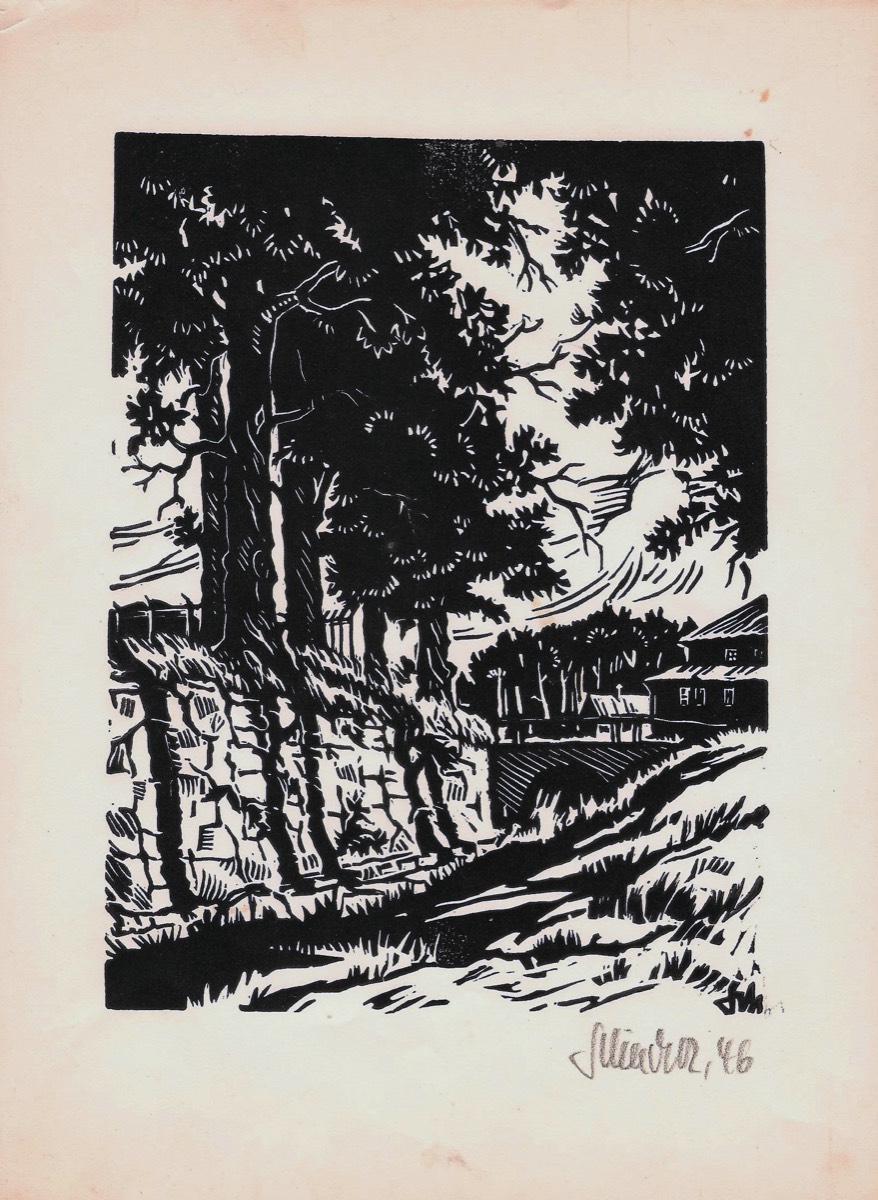
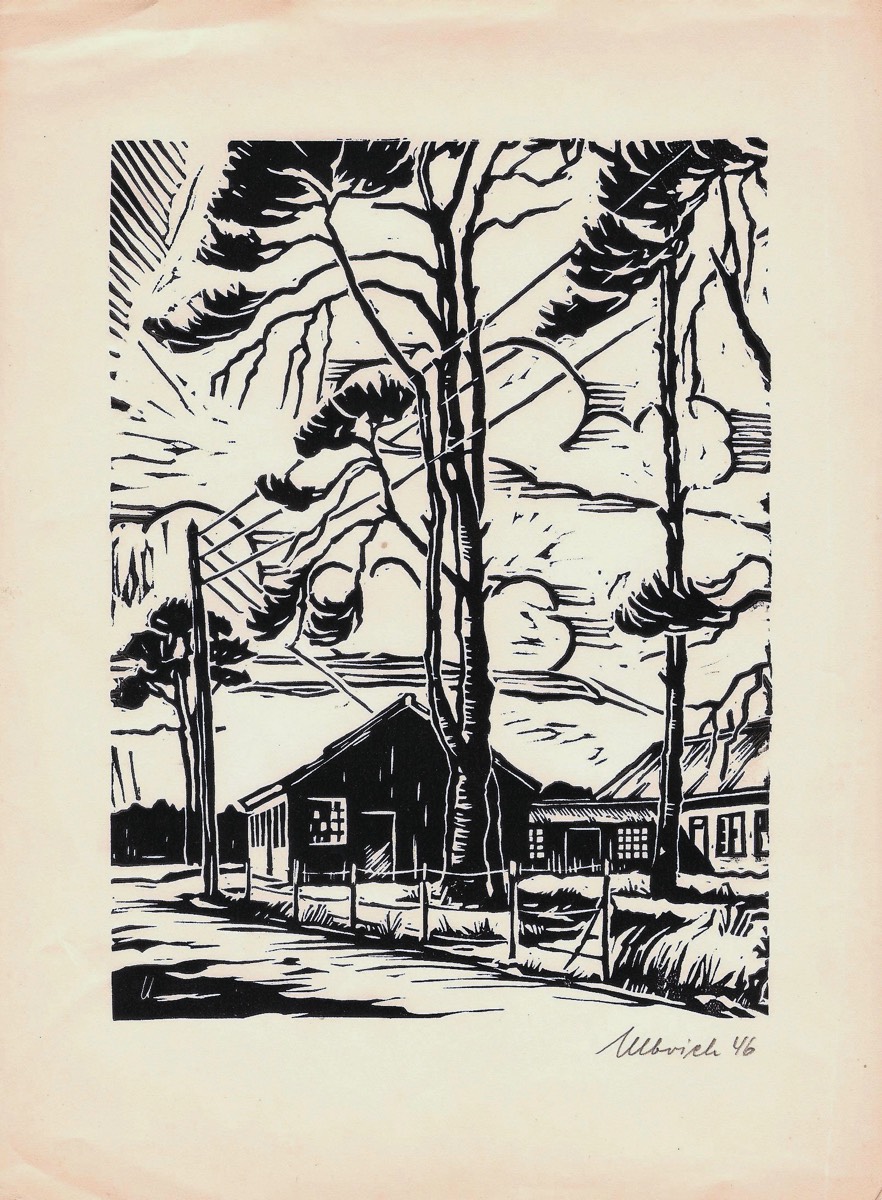


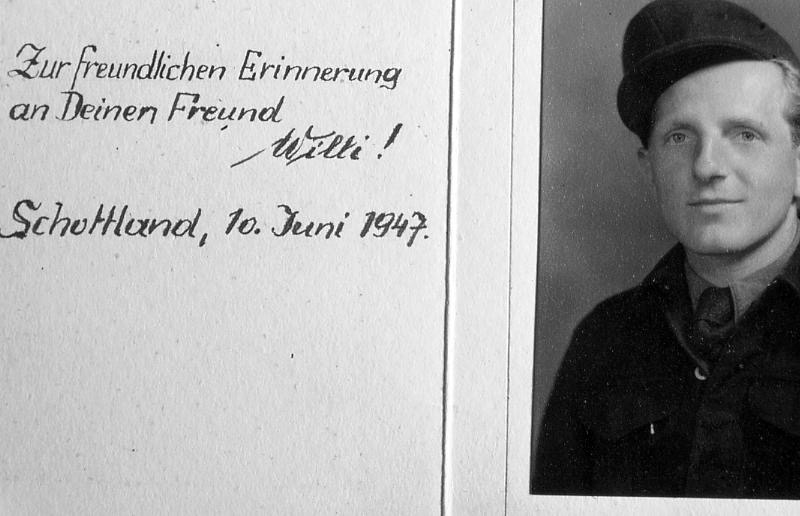
A card from Alfred Weiss, former prisoner at Gosford PoW camp 16.
CONTACT POINT - anyone who can help with these queries, please use the contact email address at the bottom of the page. Thank you.
"Please find attached a scan of the booklet of my grandfather where he collected all the addresses of family members and friends that were displaced. There are two entries for my great uncle Franz Jauernig, POW number 535835, his rank was "Obergefreiter".
One entry is about Longniddry Gosford and is barred, so I assume this address was no longer in use and the newer address was Amisfeld Haddington. At the latter entry there is also the mention in the margin of a date "18. VIII geschrieben 46", meaning that my grandfather had written a letter to my great uncle on the 18th August 1946.
Is there any information about how he ended up in a POW camp in Scotland? Where was he made prisoner, is there any information in which branch of the army he was? Was he maybe a sailor?
Thank you very much for any information."
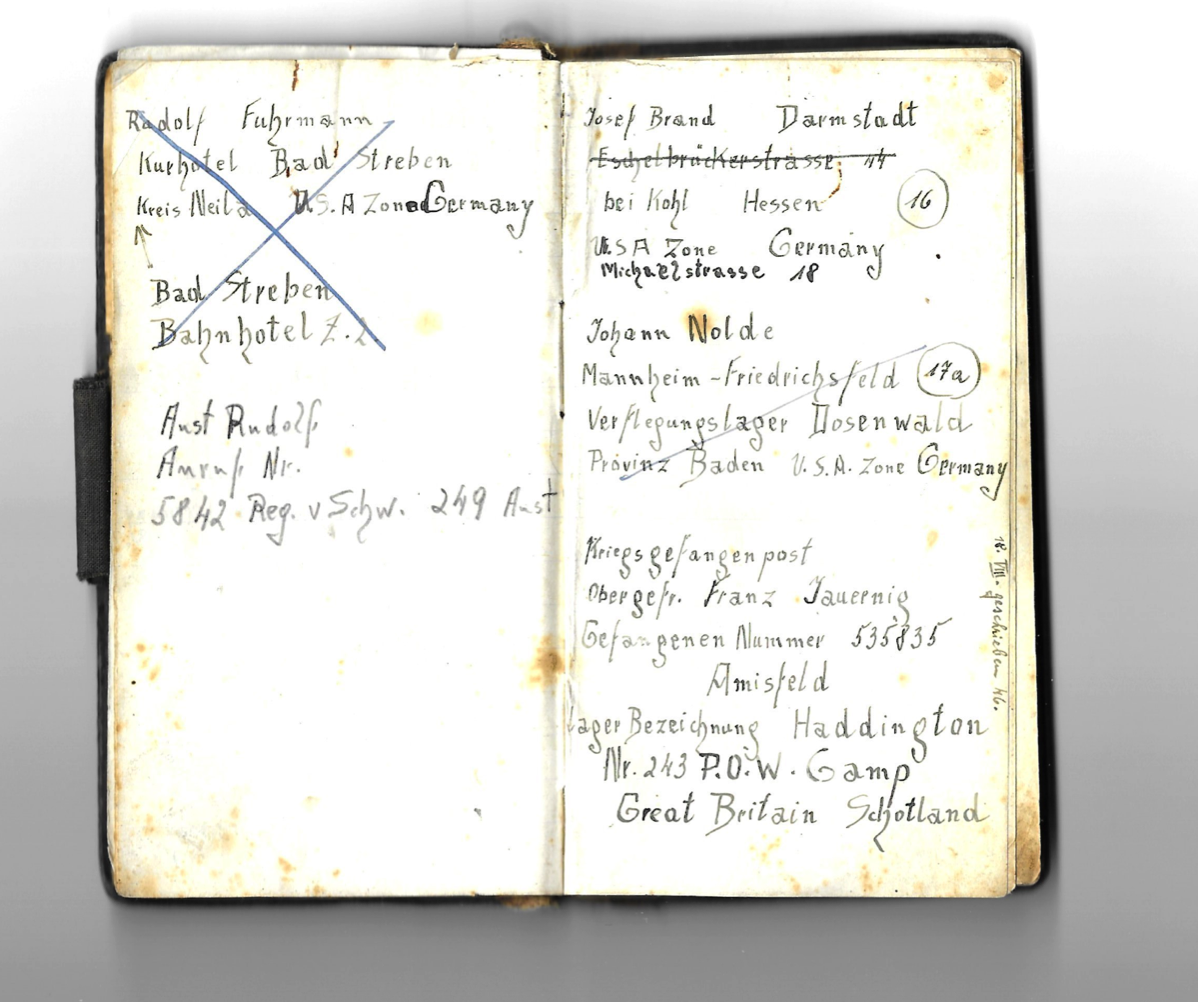
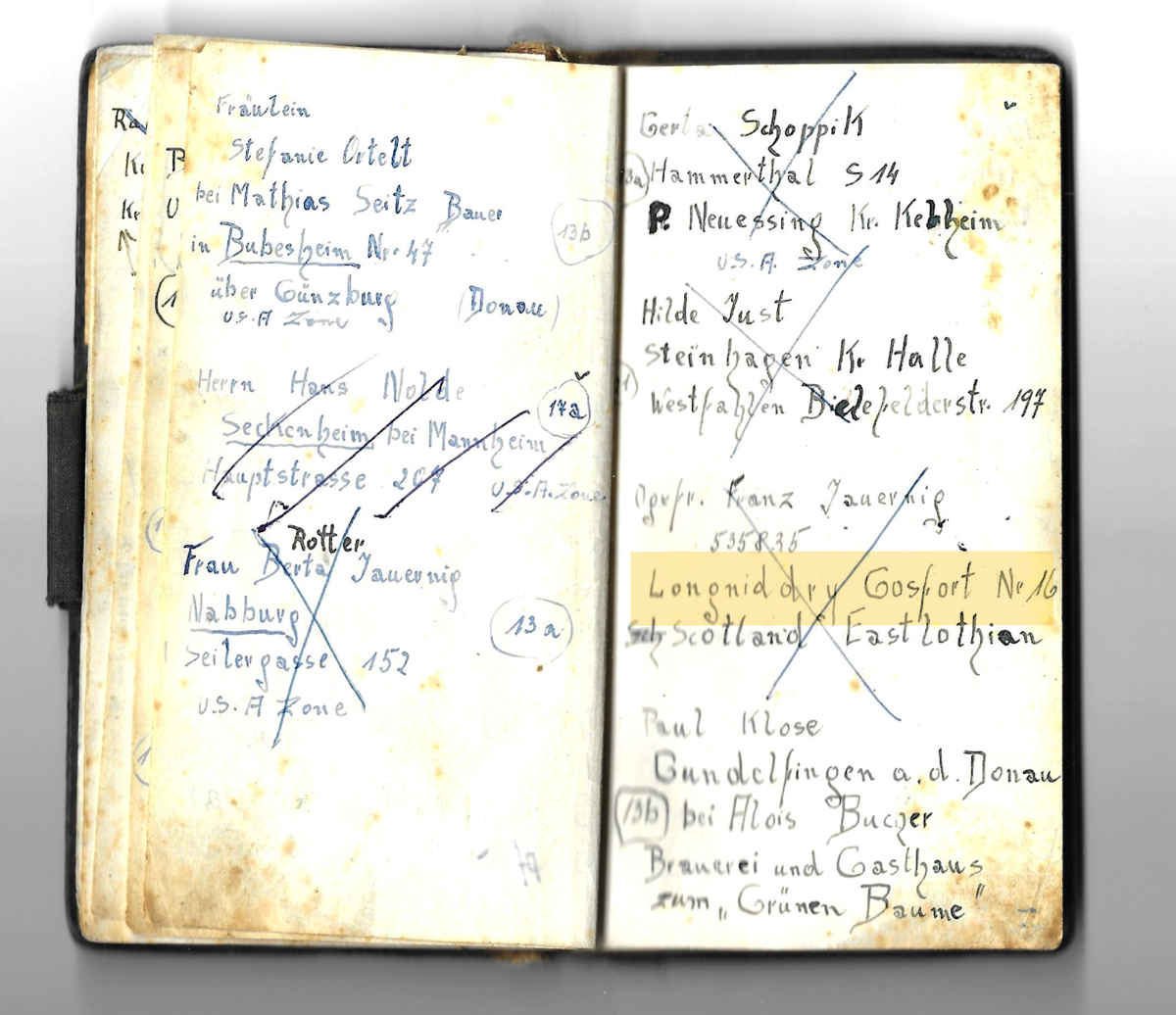
The four pages of the diary mentioned by Franz's grand niece.


